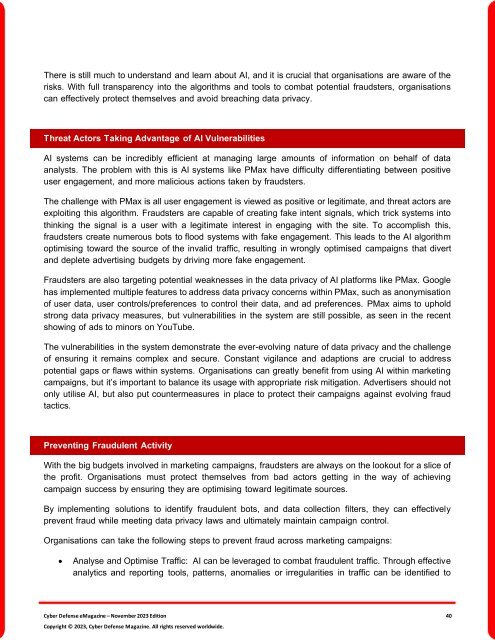The Cyber Defense eMagazine November Edition for 2023
Cyber Defense eMagazine November Edition for 2023 #CDM #CYBERDEFENSEMAG @CyberDefenseMag by @Miliefsky a world-renowned cyber security expert and the Publisher of Cyber Defense Magazine as part of the Cyber Defense Media Group as well as Yan Ross, Editor-in-Chief and many more writers, partners and supporters who make this an awesome publication! 196 page November Edition fully packed with some of our best content. Thank you all and to our readers! OSINT ROCKS! #CDM #CDMG #OSINT #CYBERSECURITY #INFOSEC #BEST #PRACTICES #TIPS #TECHNIQUES
Cyber Defense eMagazine November Edition for 2023 #CDM #CYBERDEFENSEMAG @CyberDefenseMag by @Miliefsky a world-renowned cyber security expert and the Publisher of Cyber Defense Magazine as part of the Cyber Defense Media Group as well as Yan Ross, Editor-in-Chief and many more writers, partners and supporters who make this an awesome publication! 196 page November Edition fully packed with some of our best content. Thank you all and to our readers! OSINT ROCKS! #CDM #CDMG #OSINT #CYBERSECURITY #INFOSEC #BEST #PRACTICES #TIPS #TECHNIQUES
You also want an ePaper? Increase the reach of your titles
YUMPU automatically turns print PDFs into web optimized ePapers that Google loves.
<strong>The</strong>re is still much to understand and learn about AI, and it is crucial that organisations are aware of the<br />
risks. With full transparency into the algorithms and tools to combat potential fraudsters, organisations<br />
can effectively protect themselves and avoid breaching data privacy.<br />
Threat Actors Taking Advantage of AI Vulnerabilities<br />
AI systems can be incredibly efficient at managing large amounts of in<strong>for</strong>mation on behalf of data<br />
analysts. <strong>The</strong> problem with this is AI systems like PMax have difficulty differentiating between positive<br />
user engagement, and more malicious actions taken by fraudsters.<br />
<strong>The</strong> challenge with PMax is all user engagement is viewed as positive or legitimate, and threat actors are<br />
exploiting this algorithm. Fraudsters are capable of creating fake intent signals, which trick systems into<br />
thinking the signal is a user with a legitimate interest in engaging with the site. To accomplish this,<br />
fraudsters create numerous bots to flood systems with fake engagement. This leads to the AI algorithm<br />
optimising toward the source of the invalid traffic, resulting in wrongly optimised campaigns that divert<br />
and deplete advertising budgets by driving more fake engagement.<br />
Fraudsters are also targeting potential weaknesses in the data privacy of AI plat<strong>for</strong>ms like PMax. Google<br />
has implemented multiple features to address data privacy concerns within PMax, such as anonymisation<br />
of user data, user controls/preferences to control their data, and ad preferences. PMax aims to uphold<br />
strong data privacy measures, but vulnerabilities in the system are still possible, as seen in the recent<br />
showing of ads to minors on YouTube.<br />
<strong>The</strong> vulnerabilities in the system demonstrate the ever-evolving nature of data privacy and the challenge<br />
of ensuring it remains complex and secure. Constant vigilance and adaptions are crucial to address<br />
potential gaps or flaws within systems. Organisations can greatly benefit from using AI within marketing<br />
campaigns, but it’s important to balance its usage with appropriate risk mitigation. Advertisers should not<br />
only utilise AI, but also put countermeasures in place to protect their campaigns against evolving fraud<br />
tactics.<br />
Preventing Fraudulent Activity<br />
With the big budgets involved in marketing campaigns, fraudsters are always on the lookout <strong>for</strong> a slice of<br />
the profit. Organisations must protect themselves from bad actors getting in the way of achieving<br />
campaign success by ensuring they are optimising toward legitimate sources.<br />
By implementing solutions to identify fraudulent bots, and data collection filters, they can effectively<br />
prevent fraud while meeting data privacy laws and ultimately maintain campaign control.<br />
Organisations can take the following steps to prevent fraud across marketing campaigns:<br />
• Analyse and Optimise Traffic: AI can be leveraged to combat fraudulent traffic. Through effective<br />
analytics and reporting tools, patterns, anomalies or irregularities in traffic can be identified to<br />
<strong>Cyber</strong> <strong>Defense</strong> <strong>eMagazine</strong> – <strong>November</strong> <strong>2023</strong> <strong>Edition</strong> 40<br />
Copyright © <strong>2023</strong>, <strong>Cyber</strong> <strong>Defense</strong> Magazine. All rights reserved worldwide.

















